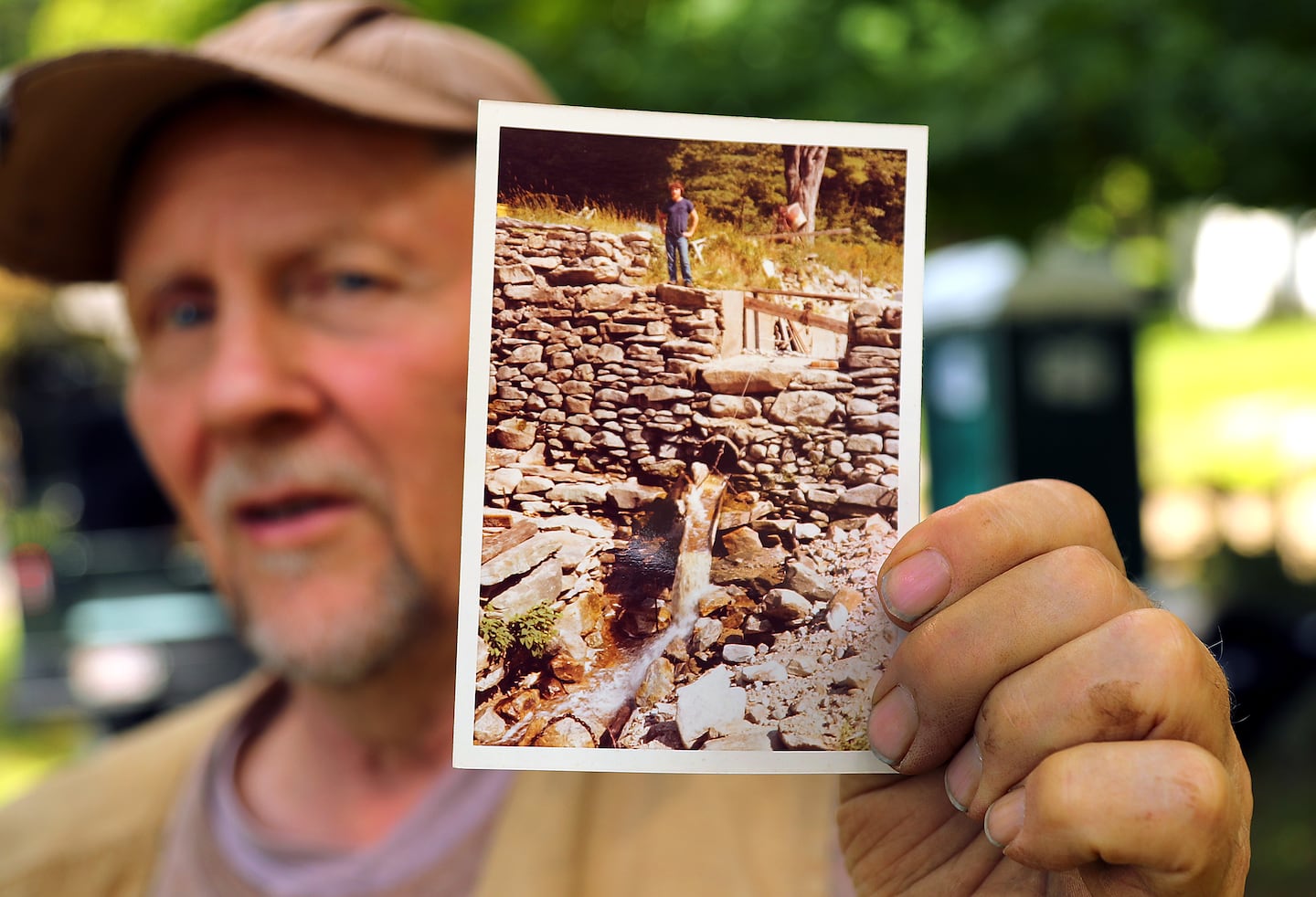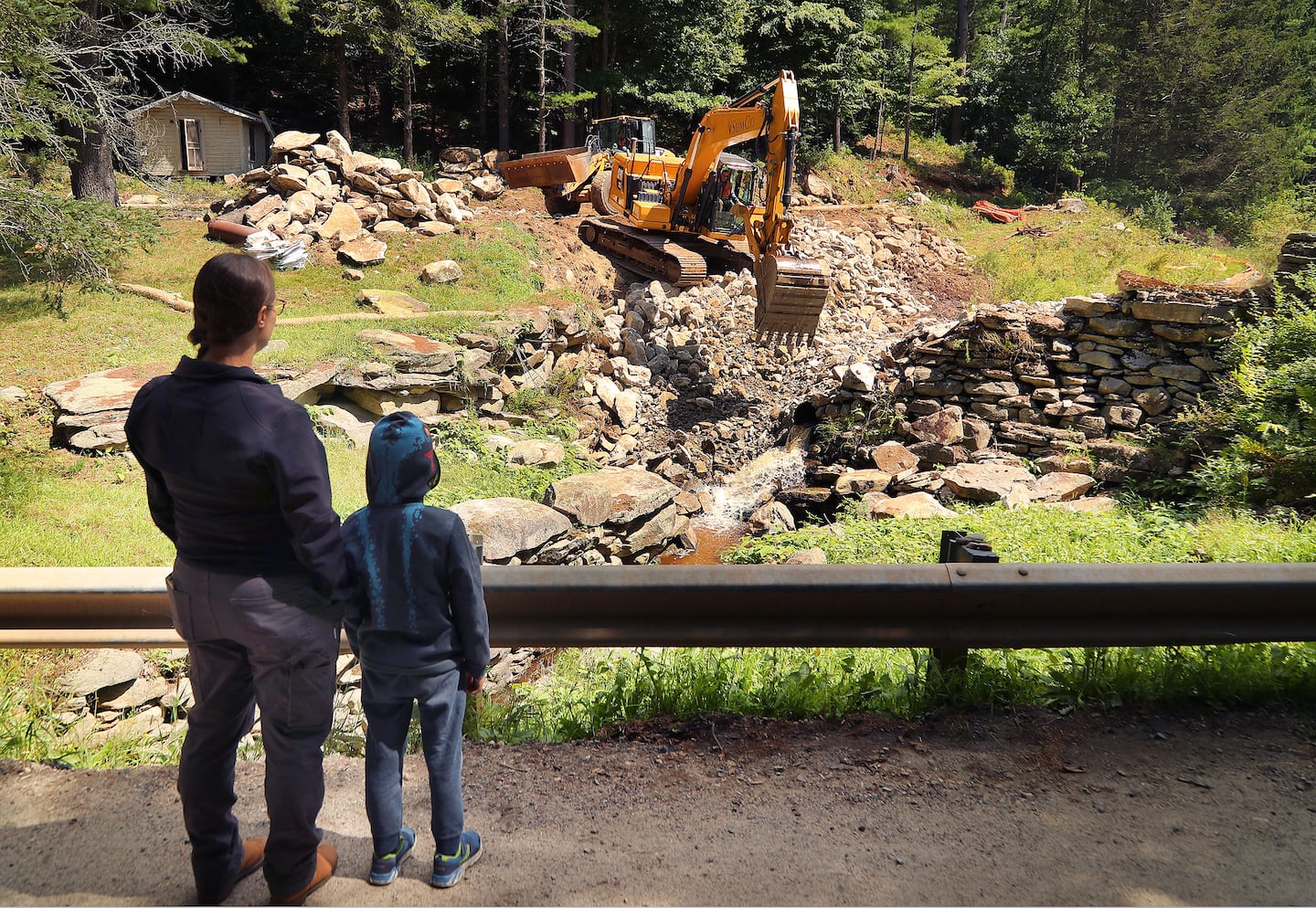But, Dudleyville Pond, as it’s known, has become much more of a burden than source of joy for the Brown family. The old stone dam at one end has long been in disrepair; for the last few decades, the pond has been only partially full and years have gone by since it floated row boats and swallowed fish hooks. Regulators warned that what was once the shining gem of Brown’s property is now a public safety hazard: If the dam failed, the resulting flood could wash out a road downstream and inundate neighboring properties.
The century-old Dudleyville Pond is one of hundreds of dams in Massachusetts that state inspectors have declared unsafe or in poor condition, according to the Department of Conservation and Recreation’s Office of Dam Safety. Brown’s options were to fix it, which could cost at least a quarter of a million dollars, or tear it down.

Lois Brown reminisced about the years spent next to the pond and dam where she still lives.
(John Tlumacki/Globe Staff)
Brown played in the pond in 1952 in Shutesbury.(Brown family photo)
That’s typical: Dam repair or removal projects are enormously expensive, and about 40 percent of dams in the United Statesare owned not by the government, but by property owners, many of whom typically do not have the money or time to maintain them.
Removing dangerous dams is a key priority for Massachusetts as it prepares for the dangers of a changing climate. Regulators are concerned that dams built decades or centuries ago may not be strong enough to withstand more intense deluges.
The Massachusetts Department of Fish and Game has a goal to remove 11 of the state’s more than 3,000 dams by 2030. The Commonwealth has the fifth-highest number of dams per mile in the nation, according to the department.
The dam at Dudleyville Pond was built more than a century ago to create power for a sawmill. The mill is long gone, but its legacy as a power source was revived in the 1980s when Brown’s brother, David, outfitted the dam with a turbine to produce electricity for their barn and cabin.
While moving forward with removal is a triumph for the state, Brown’s family isgrieving.Yes, the 8-acre pond was man-made. Nevertheless, removing it and seeing all those memories of ice skating and shore-side fishing flow away feels unnatural.
Brown said she misses rowing the most. Twilight was the best time to go: Her rowboat would carve a path through the fog and the setting sun, with the smooth, dark water below her paddle.
And at night, the pond would ooze romance when the mist rose and twirled in the moonlight under the stars.
“Therein is the heart tug of knowing that the pond isn’t going to return,” Brown said.
Brown’s daughter, Carmel, and several children of Brown’s friends played in the pond in Shutesbury in 1986.Lois Brown
About 30 years ago, Brown’s family began to receive letters from the state’s Office of Dam Safety warning them the dam was a public safety hazard. Those notices escalated over the years into threats of fines of $500 a day, Brown said. It soon became a significant source of stress for Brown, a social worker, and her brother David, 76, a hospice care worker.
“The cost of repairing it was just out of our league,” she said.
David Brown made an attempt in the early 1990s to repair the dam himself. He excavated some sections but couldn’t finish the work due to permitting and the complexity of the project.
An engineer with experience repairing such dams told the Globe the cost likely would have been close to $1 million, including permitting and design plans.
Brown pleaded with the regulators: What am I supposed to do?
Even if the state seized her home, she reasoned, no one in their right mind would buy a property with such a huge liability.
If the dam were to fail during a storm, said Chris Hirsch, dam removal program manager for the Massachusetts Division of Ecological Restoration, the road that connects the neighborhood could be washed away and downstream properties damaged; the floods could even kill someone.
Already, a neighbor downstream told regulators their home takes on water during heavy storms.
“She’s just, like, an ordinary person,” Hirsch said of Brown, “and dams are very, very expensive to own and to maintain.”
 David Brown’s property abuts the dam where he has lived for nearly 50 years. He held a photo from 1980 of himself standing atop the dam. John Tlumacki/Globe Staff
David Brown’s property abuts the dam where he has lived for nearly 50 years. He held a photo from 1980 of himself standing atop the dam. John Tlumacki/Globe Staff
In addition to the decrepit dam, a culvert beneath a road on the other side of the dam is much too small, putting the road at risk of a blowoutduring a storm.
“It was like getting in your car and saying, ‘Wow, the tires are bad all the way around, and the motor’s about to die, and I’m going to drive 128 [miles per hour] around Boston,’” said Michael Chelminski, an engineer for Stantec, a company that works on dam removals. “That’s not a winning combination.”
The 17-foot-tall dam loomed larger and larger in Brown’s mind.
She tried the engineering department at the University of Massachusetts in Amherst. Could she give them the dam? She thought it could make for a real-life engineering project for some enterprising students, but no one took her up on the offer.
She tried state representatives. They made calls for information, she said, but ultimately told her there was nothing they could do. The dam was deemed unsafe, and it was upto Brown to do something about it.
Eventually, a friend who is interested in environmental issues suggested Brown look into having the dam removed and told her about the potential benefits to the ecosystem: Native species of fish could move freely up and down the Sawmill River, along which the dam was built. Birds would rely on the wetlands, and those wetlands would act as a sponge for flash flooding.
In the last two years, beavers built a dam of their own in the partially drained pond, pooling water behind avoid that had once been dug out during one of the attempts to repair the dam. That made the dam problem much more urgent, experts said.
“If you had a big storm that came through, [the water] could potentially spill into that void space, and then undermine the foundation of the dam, causing a dam failure,” Hirsch said.
 A blue heron walked through the mucky bottom of the pond, which is void of water after the removal of the Dudleyville Pond dam.John Tlumacki/Globe Staff
A blue heron walked through the mucky bottom of the pond, which is void of water after the removal of the Dudleyville Pond dam.John Tlumacki/Globe Staff
The state granted an emergency removal order, bypassing much of the lengthy and expensive permitting processes. To finance the removal, the Massachusetts Department of Ecological Restoration, US Fish and Wildlife, the Connecticut River Conservancy, local chapters of Trout Unlimited, and other nonprofit organizations worked together to come up with $118,000 in various grants to cover the cost of the emergency removal.
Permitting and designing a dam removal typically takes three to five years and costs millions of dollars, engineers said. This one occurred in a matter of months and cost a fraction of that.
Last week, the dam was carved away from the stream bed with an excavator. What’s left behind is a pit of mud, some tall slimy grasses, and a crane poking around in the puddles. It’s a far cry from the idyllic scene Brown grew up with.
However, Brown said that she’s looking forward to seeing the ecosystem recover.
“It does help soften the hurt,” she said. “It feels like we’re doing the right thing.”
 The old Dudleyville Pond Dam was taken down by heavy construction equipment after an emergency order because of a high risk of failure. Erin Jacque watched the removal of the dam with her son, Xavier, 7. She helped dam owner Lois Brown with the process of getting it taken down.John Tlumacki/Globe Staff
The old Dudleyville Pond Dam was taken down by heavy construction equipment after an emergency order because of a high risk of failure. Erin Jacque watched the removal of the dam with her son, Xavier, 7. She helped dam owner Lois Brown with the process of getting it taken down.John Tlumacki/Globe Staff
Erin Douglas can be reached at [email protected]. Follow her @erinmdouglas23.
Source link : http://www.bing.com/news/apiclick.aspx?ref=FexRss&aid=&tid=66d6be501d38422889b433fb04081107&url=https%3A%2F%2Fwww.bostonglobe.com%2F2024%2F09%2F02%2Fscience%2Fmassachusetts-dam-removal-floods-shutesbury-pond%2F&c=5983076701365228658&mkt=en-us
Author :
Publish date : 2024-09-02 05:02:00
Copyright for syndicated content belongs to the linked Source.





